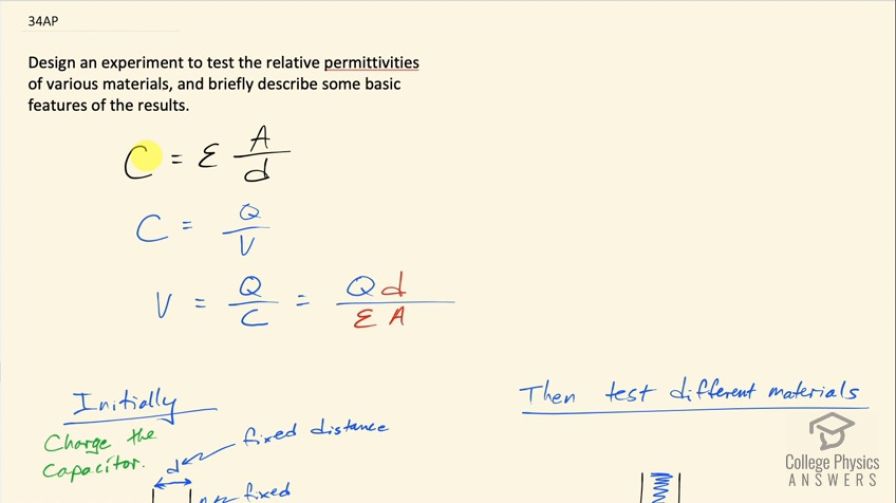Question
Design an experiment to test the relative permittivities of various materials, and briefly describe some basic features of the results.
Final Answer
- Charge the capacitor to voltage with no dielectric.
- Remove the battery and replace it with a voltmeter.
- Measure the voltage when different materials are inserted between the plates. Each material needs the exact same size and thickness.
- Populate the data table with relative permittivities, knowing that
Solution video
OpenStax College Physics for AP® Courses, Chapter 19, Problem 34 (Test Prep for AP® Courses)

vote with a rating of
votes with an average rating of
.
Video Transcript
This is College Physics Answers with Shaun Dychko. We need to design an experiment that will test the relative permittivities of different materials and we are going to consider a parallel plate capacitor and it has a fixed distance between the plates and some fixed area of course and we are going to charge it up using some known voltage V naught and then we will afterwards take out the battery so notice this is a difference between these diagrams here there's a battery initially to charge up the capacitor with no dielectric or, in other words, no material between the plates and then we take out the battery and put in a voltmeter and then introduce some material here, which will have some different permittivity. So based on what we see up here, we know that capacitance of a parallel plate capacitor is its permittivity times the area of the plates divided by the distance between them and capacitance can also be expressed as the charge on each plate divided by the voltage between them and voltage is... we can solve for it by multiplying both sides by V over C and voltage is the charge divided by capacitance and if we substitute in for C, we get that voltage is Qd over permittivity times area where I am multiplying by the reciprocal of this so flipping this over and then multiplying that by Q. Okay! So the experiment will involve step (1) charging up the capacitor with this voltage V naught when there's no dielectric in which case we have nearly the permittivity of free space ε naught I guess there's going to be air here so it's not precisely going to be ε naught but it's going to be our reference permittivity that we are going to be measuring relative to. And then we remove the battery and replace it with a voltmeter and then we have different materials that are all cut in the exact same size and thickness because the size and thickness changes the permittivity of materials so we don't want to be measuring changes due to differences in sizes and thicknesses, we want to measure changes due to the substance itself so we need to make sure the size and thickness is consistent among the different samples of different materials. So we'll one by one insert different materials between the plates in this step here measuring the voltage each time and the voltage would be this charge that will be the same as it was before because we haven't discharged the capacitor— we just removed the battery and put in a voltmeter— and the distance is the same as before and the area is the same as before so all these factors are the same with the exception of this permittivity, it doesn't have the subscript o on it. Okay! And we know that if you go V naught divided by V that's Qd over ε naughtA and then multiply by the reciprocal of the expression for V that's εA over Qd, this will end up being the relative permittivity it will be the permittivity of the material divided by this reference permittivity that we had with no material between the plates so to get this relative permittivity, we go V naught divided by V. So we are going to first start with no material, we measure this voltage V naught the relative permittivity of course will be 1 because it's going to be V naught divided by V naught and then we substitute in material A and we'll get some voltage V A and then we go V naught divided by V A and we'll get some number greater than 1. We know that because this permittivity is going to be greater with some material here than with no material and so this voltage is going to be less and so V naught divided by some number less than itself is going to be a result that's greater than 1. So carry on like this... another material B, measure its voltage V B and get some other relative permittivity and there we go!